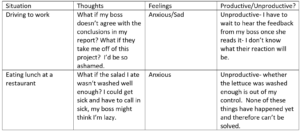
Everyday Mental Health Series: Working with Worry
Dr. Amanda Beaman, C.Psych
Now that we’ve covered some basics with regard to the relationship between our thoughts and feelings , and some of the types of thoughts that underlie anxiety and depression, let’s discuss a specific, chronic pattern of thinking that is associated with anxiety-namely worry.
Worry is something we all do. Some of us do it more than others. Unfortunately we are not going to get rid of it! Hence the title of this article, “working with worry”. This realization may be disappointing to some of you, as it also is for many of our clients. However, a more sustainable approach than trying to get rid of worry is to learn how to relate to worries differently. Also, sometimes worry can be “productive” and we don’t want to get rid of them. Dr. Robert Leahy has spent a large part of his career studying worry. He refers to “productive and unproductive worry” (see below) in his conceptualization of the causes of generalized anxiety. His book called The Worry Cure, is packed full of helpful advice about managing worry.
Productive worry refers to thoughts about problems that exist in the here and now, and for which steps can be taken to solve very soon. For example, let’s say that I realized in this moment that I forgot to pay my electrical bill. I might have a pang of anxiety at this realization, understanding that there could be consequences to a missed payment. This problem exists right now, and there are some obvious steps I can take to solve it (i.e. go online and pay it). Therefore, as long as I don’t allow the problem to go unsolved by avoiding it (more on this later), my anxiety about my bill reduces swiftly. Sometimes just knowing what the steps are to solve a problem reduces anxiety. In this case the anxiety was helpful to motivate me to take action on paying my bill.
Unproductive worry refers to 1) problems that don’t exist yet or, 2) things that are out of our control. In the first case, these are “problems” that are constructed by our minds, and are usually about the future. For example, I might think, “what if I forget to pay my electrical bill when it comes due next month?” Or, “what if I get sick on our vacation?” These problems haven’t happened yet, and are therefore unsolvable. While there may be some steps to take to prepare, such setting up a reminder to pay my bill, merely thinking about whether the negative event could happen, and all the consequences of that, is completely unproductive. This also applies to things that are out of my control. For example, if I continually think about conflict that occurred with a stranger at the grocery store, wondering why they reacted the way they did, I am engaged in unproductive worry. Other people’s thoughts, reactions, and feelings are out my control, and no amount of thinking about them will change that. When we get stuck repeatedly thinking about negative events that are either unsolvable or unknowable, it ramps up our anxiety system, and because we never find a solution or answer, the anxiety is maintained as long as we’re thinking about it, and possibly for some time afterward.
Unproductive worry is sneaky, it may feel like we are problem solving when we are really just worrying. Learning how to distinguish between productive and unproductive worry is an important step to relating to worry more effectively.
Try tracking your worries by writing them down for a week, categorizing them as productive or unproductive (see examples below). Then, stay tuned for a next article in which we will discuss the next steps of dealing with unproductive worry.
E.g.

